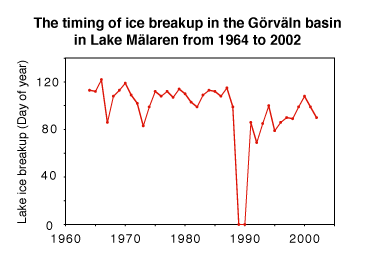 |
||
|
Impact of warmer winters on the timing of lake ice breakup |
||
|
Like Swedish lakes in general Sweden's largest lakes Vänern, Vättern and Mälaren were also affected by a trend towards earlier ice breakup and despite their large area they showed the same rate of change in the timing of ice breakup up as small lakes that were located in the same climatic region. In Vänern and Vättern more years without any continuous ice cover have been observed during the 1990s and even in Mälaren, two winters without ice cover have been registered1,2. These icefree winters occurred during the two extreme warm winters 1988/89 and 1989/90. After these extreme winters the timing of ice breakup remained early (see figure).
|
Ice breakup in Sweden's largest lakes
1 Weyhenmeyer, G. A. 2001. Warmer winters - are planktonic algal populations in Sweden's largest lakes affected? Ambio 30: 565-571. 2 Westöo, A.-K. 2004. Warmer winters - how are water chemistry and phytoplankton in Sweden's largest lakes affected (in Swedish)? Master Thesis. Department of Environmental Sciences, Swedish University of Agricultural Sciences.
|
|
